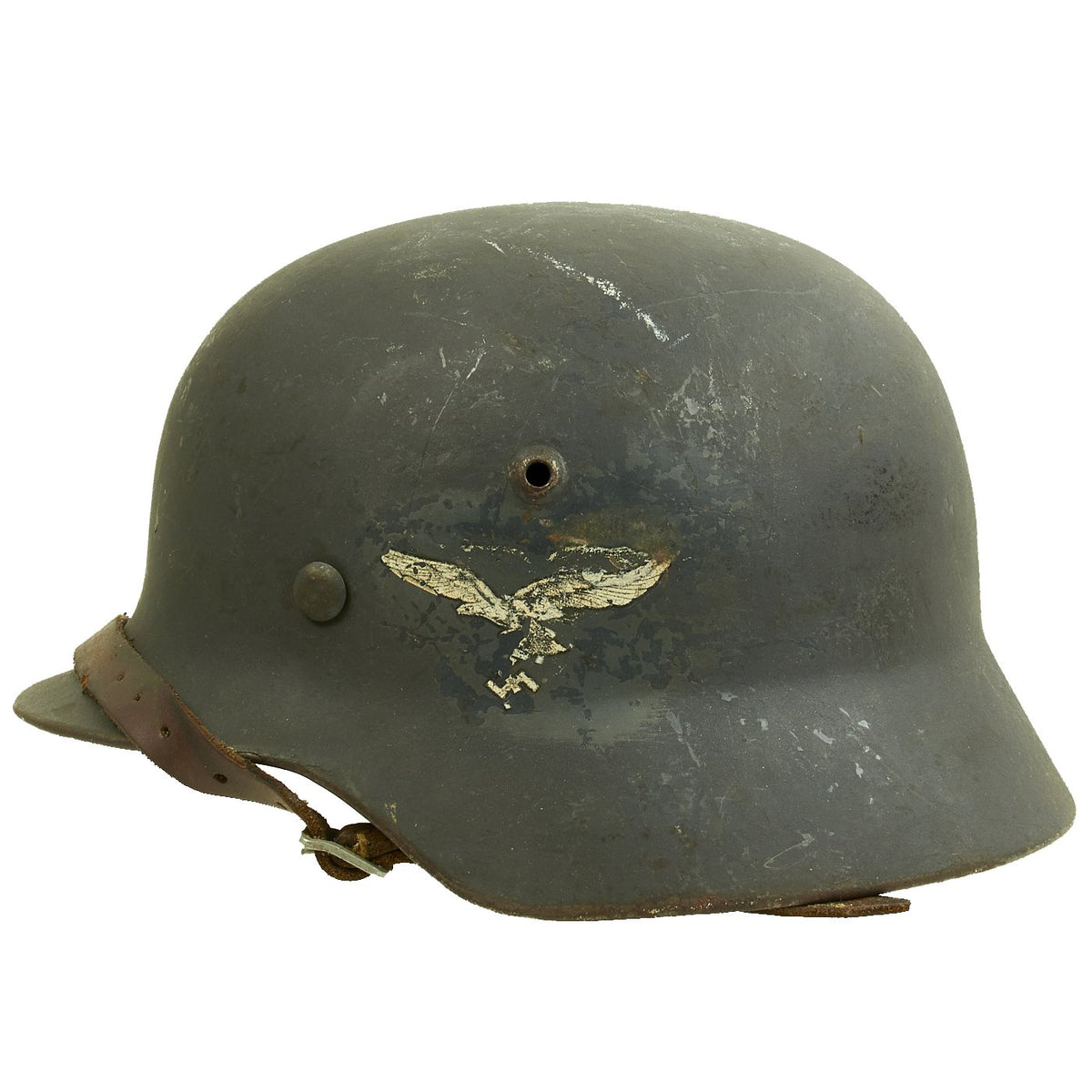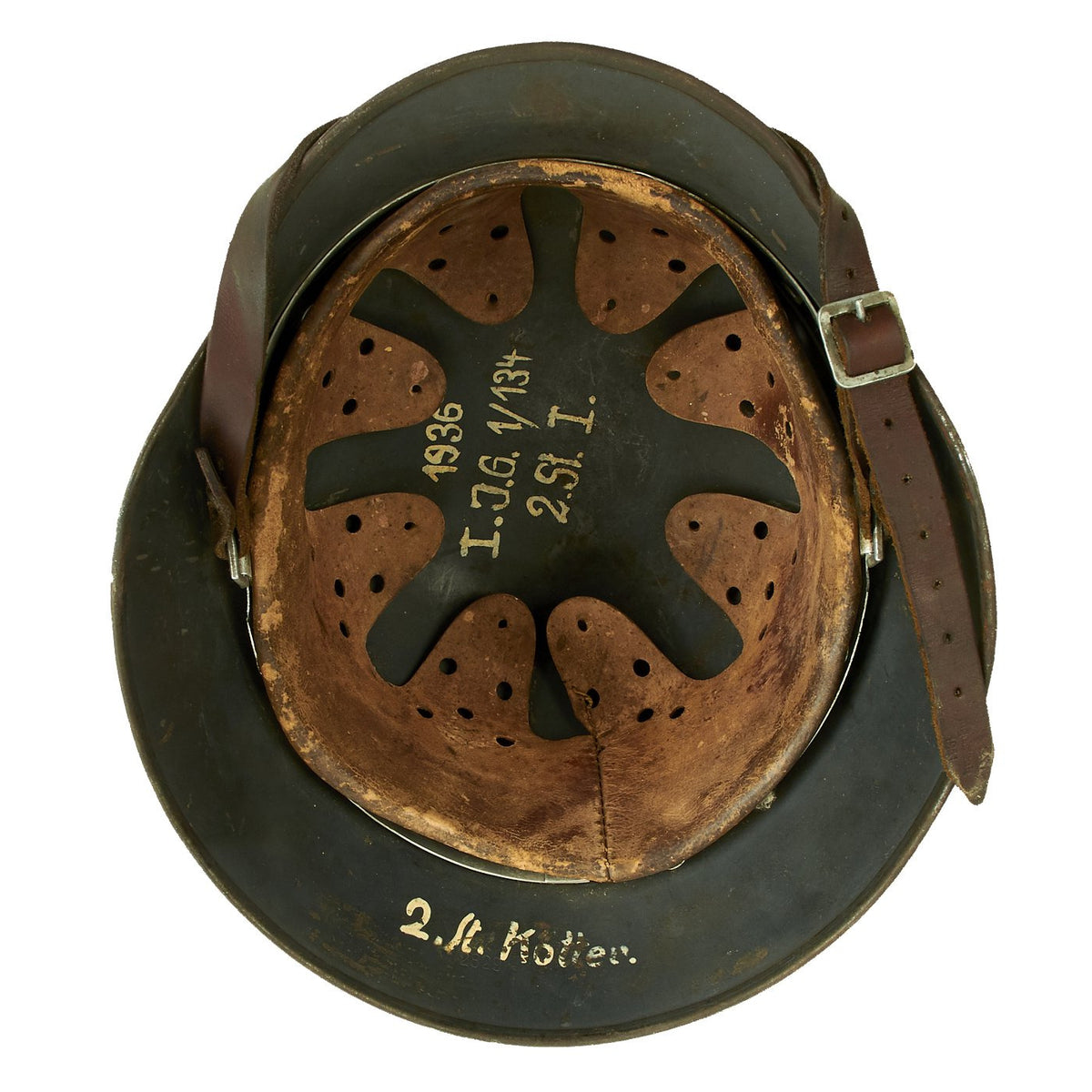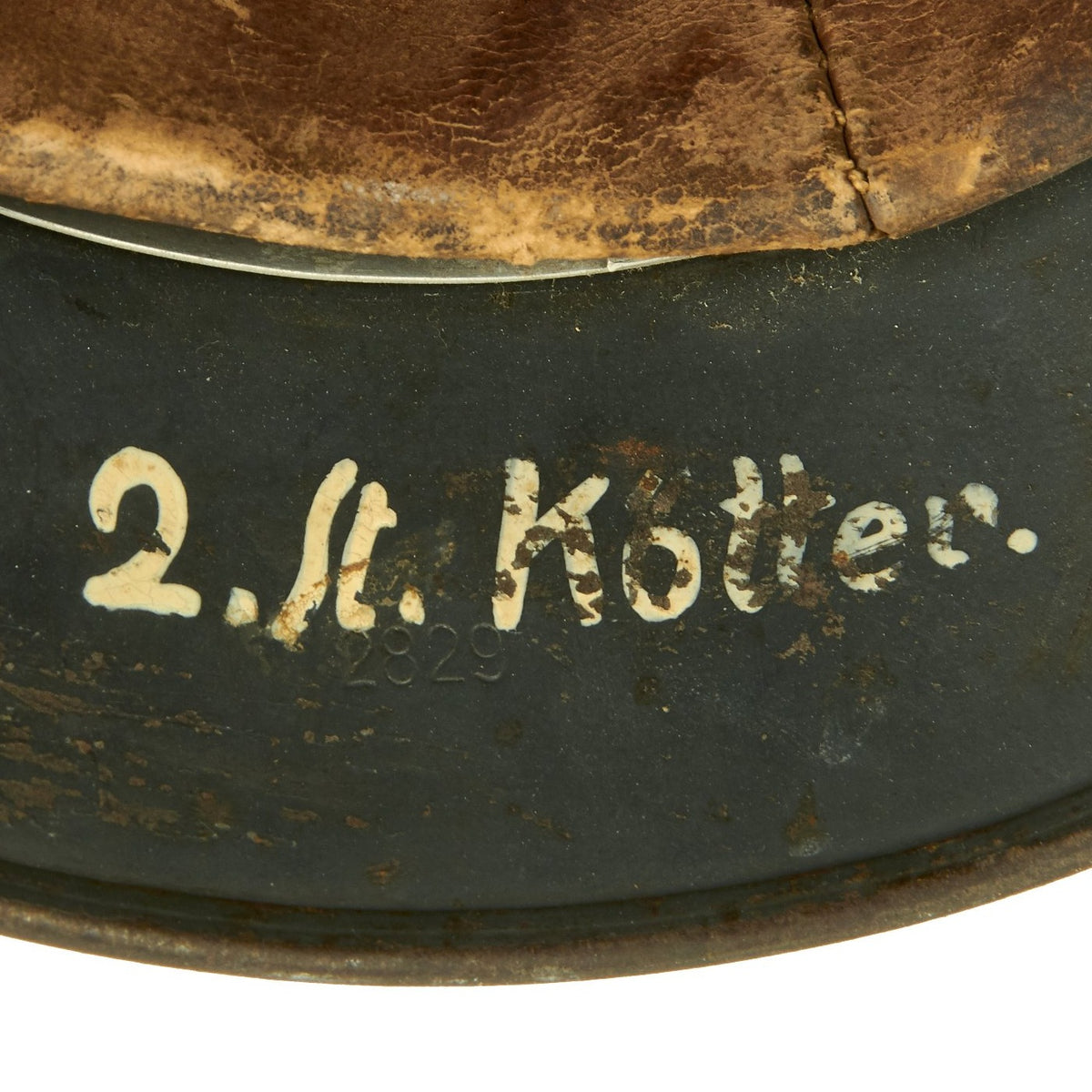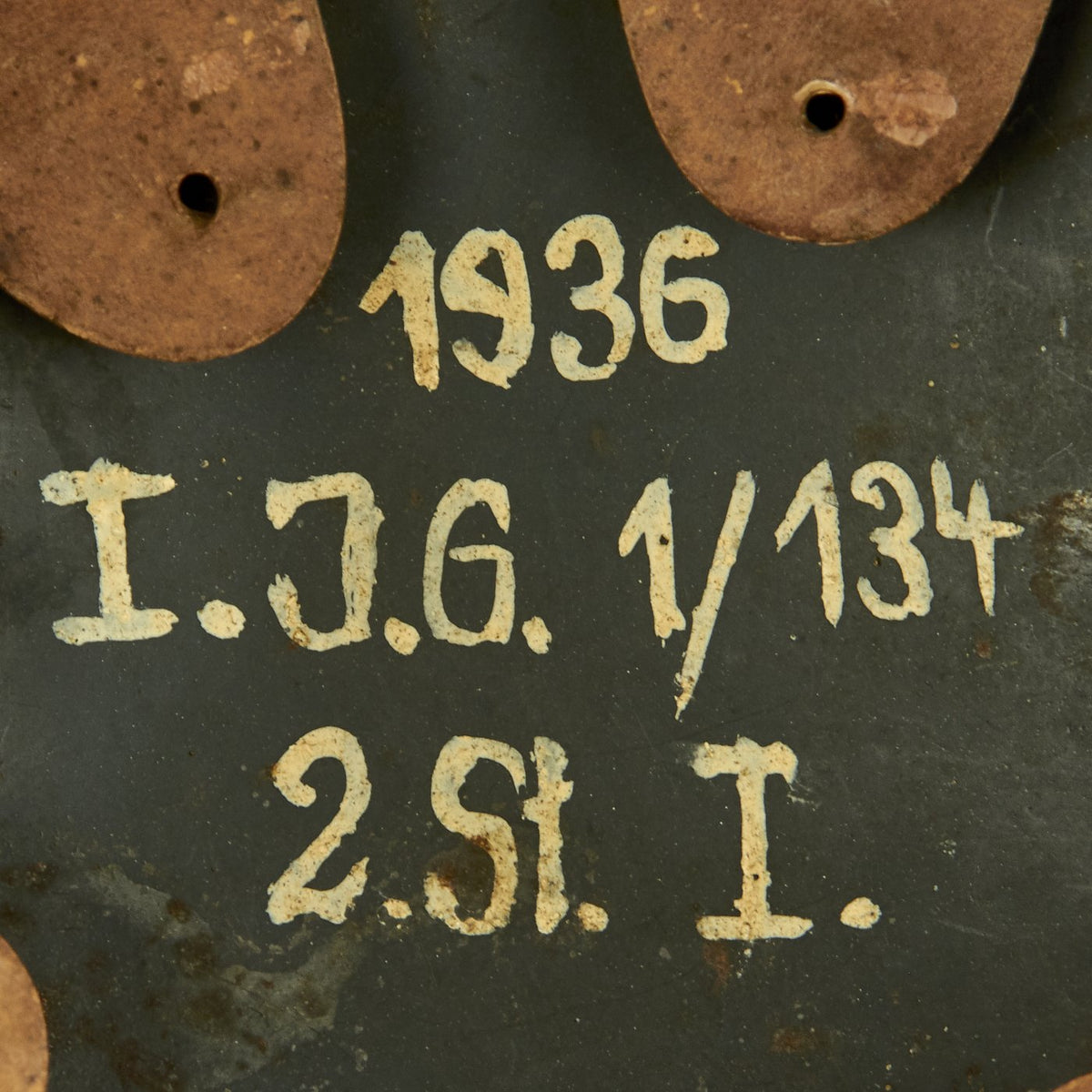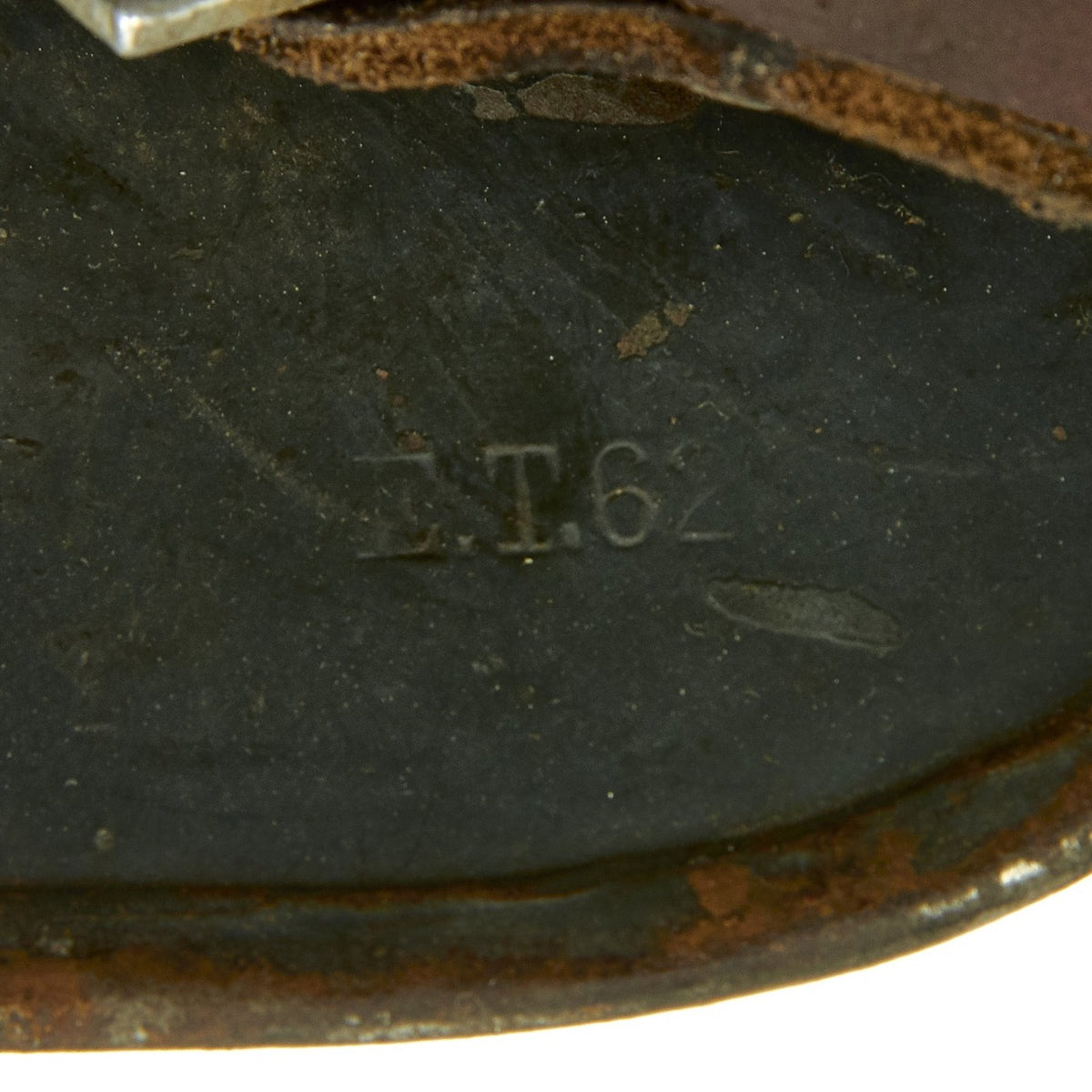Original German Pre-WWII 1936 dated Luftwaffe Unit Marked M35 Double Decal Steel Helmet – ET62 Original Items
$ 1.195,00 $ 298,75
Original Item: Only One Available. This is an incredible all original example of a very early Model 1935 German Pre-WWII “double decal” helmet, with lots of history and research potential! This helmet appears to have been overpainted with lightly textured Luftwaffe blue at some point, but that was removed, showing that it was originally issued with both decals. It looks like an early “Droop-Tail” Luftwaffe Eagle decal is on the left side, and a “National Colors” decal on the right. Unfortunately the decals are somewhat covered with paint still, and have parts missing, so we cannot verify the legs of the eagle to confirm it is a “Droop-tail”. The decals are still both retained at over 50%, and it looks like the eagle may have even had another eagle decal on top of it at one point. Just lots to take in, and we aren’t even at the best parts!
While the exterior was overpainted once, the interior was not, and it has some incredible painted on unit markings! The rear skirt is marked with:
2. St. Kotten.
The inside of the top dome is marked with a date and a different unit marking.
1936
I.J.G 1 / 134
2.St. I.
We unfortunately have not been able to decipher these markings, so we leave them as an excellent research project.
All three liner retaining pins are intact, with varying amounts of paint remaining. The reverse, interior, neck guard apron is batch number stamped 2829, and the interior, left side, apron has a stamped manufacturer’s code and size, ET62. This indicates it was manufactured by Eisenhuttenwerk AG of Thale, located in the Harz district in Saxony, Germany in size 62. Size 62 is a nice smaller size that can accommodate liners from 54cm to 55cm or US 6 3/4 to 6 5/8.
The helmet still has its correct good condition VERY EARLY M31 liner, with all 8 fingers intact and flexible. The leather is still somewhat soft, and does not show major wear, though the top tie is missing. The liner band is the correct early war aluminum, correct for a helmet of this vintage, and is marked on the left side with 62, indicating the shell size it fits. In this case, the size information is stamped into the leather itself, with the full manufacturer information:
SCHUBERTH-WERKE A.G.
19 62 31
55
BRAUNSCHWEIG
The right outer side of the liner band also has the full manufacturer and date, which is clearly stamped:
D.R.P.
SCHUBERTH-WERK
BRAUNSCHWEIG
1931
This liner does not have additional aluminum layer around the chin strap bales for reinforcement, which is correct. This is the earliest liner that we have ever seen, probably kept at arsenal for years due to the rare smaller size, and then fitted to what is a VERY early M-35 helmet.
The chinstrap is intact, and still soft, though it looks like it is a wartime arsenal replacement. It has all galvanized steel hardware, and is marked Riebel & Söhne / Ingolstadt / 1941.
Overall a very nice 100% genuine very early double decal Luftwaffe helmet with loads of history and research potential! We do not get helmets like these very often at all. Ready to display!
The first “modern” steel helmets were introduced by the French army in early 1915 and were shortly followed by the British army later that year. With plans on the drawing board, experimental helmets in the field, (“Gaede” helmet), and some captured French and British helmets the German army began tests for their own steel helmet at the Kummersdorf Proving Grounds in November, and in the field in December 1915. An acceptable pattern was developed and approved and production began at Eisen-und Hüttenwerke, AG Thale/Harz, (Iron and Foundry Works), in the spring of 1916.
These first modern M16 helmets evolved into the M18 helmets by the end of WWI. The M16 and M18 helmets remained in usage through-out the Weimar Reichswehr, (National Defence Force, Circa 1919-1933), era and on into the early years of the Third Reich until the development of the smaller, lighter M35 style helmet in June 1935.
The Luftwaffe pattern national eagle was originally introduced for wear by Fliegerschaft, (Pilot Base), personnel of the DLV, Deutscher Luftsportsverband, (German Air Sports Association), the clandestine, civilian, forerunner of the Luftwaffe on August 18TH 1934, and adopted for wear by the Luftwaffe on March 1ST 1935 along with the national tri-color shield for wear on the helmet.
The first pattern national eagle was utilized until a modified second pattern eagle was introduced in late 1936 or early 1937. Regulations of June 12TH 1940 discontinued the use of the national tri-color decal and further regulations of August 28TH 1943 abolished the national eagle decal and dictated that it was also to be removed from all helmets although the directives were not completely adhered to.
Fast Shipping with Professional Packaging
Thanks to our longstanding association with UPS FedEx DHL, and other major international carriers, we are able to provide a range of shipping options. Our warehouse staff is expertly trained and will wrap your products according to our exact and precise specifications. Prior to shipping, your goods will be thoroughly examined and securely secured. We ship to thousands clients each day across multiple countries. This shows how we're dedicated to be the largest retailer on the internet. Warehouses and distribution centres can be located throughout Europe as well as the USA.
Note: Orders with more than one item will be assigned a processing date depending on the item.
Before shipping before shipping, we'll conduct a thorough inspection of the items you have ordered. Today, the majority of orders will be delivered within 48 hours. The delivery time will be between 3-7 days.
Returns
The stock is dynamic and we cannot completely manage it because multiple stakeholders are involved, including our factory and warehouse. So the actual stock may alter at any time. It's possible that you may not receive your order once the order has been made.
Our policy is valid for a period of 30 days. If you don't receive the product within 30 days, we are not able to issue a refund or an exchange.
You can only return an item if it is unused and in the same state as the day you received it. You must have the item in its original packaging.
Related products
Uncategorized
Uncategorized
Uncategorized
Uncategorized
Uncategorized
Armoured Fighting Vehicles of the World: AFVs of World War One (Hardcover Book) New Made Items
Uncategorized
Uncategorized
Uncategorized
Uncategorized
Uncategorized
Uncategorized
Uncategorized
Australian WWII Owen MK1 Machine Carbine SMG Custom Fabricated Replica with Sling Original Items
Uncategorized
Band of Brothers ORIGINAL GERMAN WWII Le. F.H. 18 10.5cm ARTILLERY PIECE Original Items
Uncategorized
Uncategorized
Uncategorized
Uncategorized
Uncategorized
